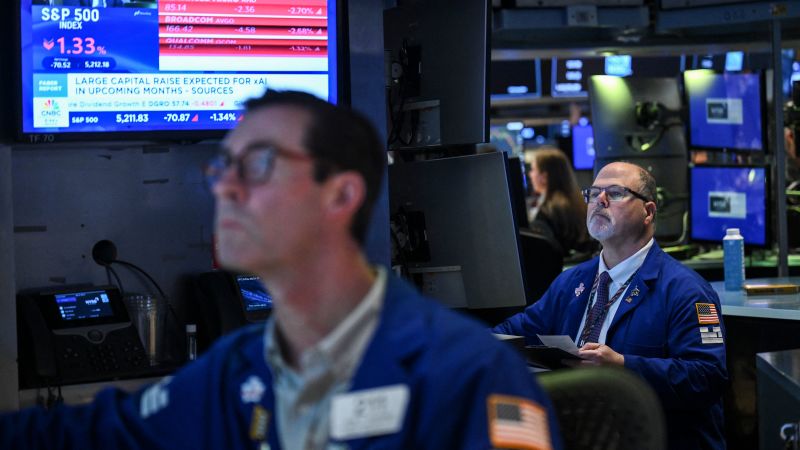A version of this story appeared in CNN Business’ Nightcap newsletter. To get it in your inbox, sign up for free here.
New York
CNN
—
If you thought President Donald Trump’s trade war seemed chaotic, buckle up: His latest salvo poses an even greater threat to the economy.
After months of swearing up and down he wouldn’t fire Federal Reserve Chair Jerome Powell, Trump on Thursday reversed course and said Powell’s “termination” couldn’t come soon enough. Stocks fell sharply.
Then US stock traders had a nice three-day weekend — the first sunny and warm spring weather New York City has seen this year — to ponder whether Trump was serious. Perhaps Thursday’s threat was just a bit of bluster from a president prone to tantrums — a one-off social media post that his more stable advisers will surely try to rein in to avoid an all-out panic.
Or…not.
Shortly after the US stock market opened Monday morning, Trump once again attacked Powell for ostensibly not cutting interest rates fast enough. Stocks immediately tumbled and the US dollar fell to its lowest level in three years.
While Trump’s tariff plan has been disruptive, the uncertainty it created had, to an extent, become priced in. Markets famously hate uncertainty, but the 90-day pause on the administration’s most aggressive tariffs offered a measure of reassurance that Trump may relent if there’s enough of a negative reaction.
Attacking the independence of the Federal Reserve is a new level of recklessness that few thought possible. But now even Kevin Hassett, the White House adviser who literally wrote a book arguing against firing the Fed chair, is saying openly that the administration is discussing whether to do so before Powell’s term ends a year from now.
To be sure, these attacks on Powell could prove empty threats. Trump may be blowing off steam or teeing up Powell as a scapegoat for a future tariff-driven recession, said Krishna Guha, vice chairman of Evercore ISI, in a note.
“But this is self-defeating,” he writes. By publicly undermining Powell, Trump “risks putting upward pressure on inflation expectations, making it harder for the Fed to cut rates.”
Putting aside the very real legal question of whether Trump can actually oust a sitting Fed chair (tl;dr: it’s debatable), here’s why Trump’s renewed fixation on Powell, whom Trump himself appointed in 2017, is so concerning:
The Fed, an independent body that sets US monetary policy, is the ultimate economic safety net. It has the power to absorb big shocks — like a pandemic, say, or a recession triggered by the upending of global trade — through interest rate policy-setting and the use of its virtually unlimited balance sheet.
During the 2022-2023 inflation crisis, the Fed raised rates at a historic pace. Undoubtedly, former President Joe Biden wasn’t pleased that mortgages, credit card rates and auto loans were suddenly surging, exacerbating America’s affordability crisis. But the Fed accomplished its mission, bringing inflation down near normal levels without plunging the economy into a recession.
Take away that independence, and you take away the Fed’s ability to keep prices in check.
“Fighting inflation requires being non-political and non-partisan,” said Erasmus Kersting, an economics professor at the Villanova School of Business. “Otherwise, the temptation to boost the economy for political gains is ever-present, and especially populist leaders have given in to that temptation all the time.”
Presidents like when the Fed cuts rates because it spurs economic growth, but it also leads to higher inflation. Once the public, including global investors, loses faith that there’s any real will to stop it, “that inflation is almost impossible to dislodge,” Kersting added.
In other words, the Fed is a buffer against the worst effects of Trump’s economic whims.
Trump wants the Fed to cut rates faster, but a big part of the reason for the Fed’s caution is Trump’s own tariff agenda, which is “highly likely to generate at least a temporary rise in inflation,” as Powell noted in a speech last week.
Putting in place a Fed chair willing to take orders from Trump would undermine the credibility of the world’s most important central bank, further eroding America’s unique position as the most trusted place to park money and investments. But it could also severely hurt the economy.
Cutting rates fast and sharply could reignite inflation just as Trump’s tariffs slow economic growth to a crawl — the Fed’s GDPNow tool currently predicts the economy went into reverse and contracted last quarter.
Any actual attempt to fire Powell, which Evercore analysts said Friday was not likely, would lead to a surge in “stagflation trades,” Guha said, referring to the nasty combo of an economy suffering from slow growth and high prices at the same time. (See also: American in the 1970s.) The resulting panic would cause bond yields to shoot higher (read: borrowing money to buy a home or car would become even more expensive), and, according to Guha, likely guarantee a recession.

